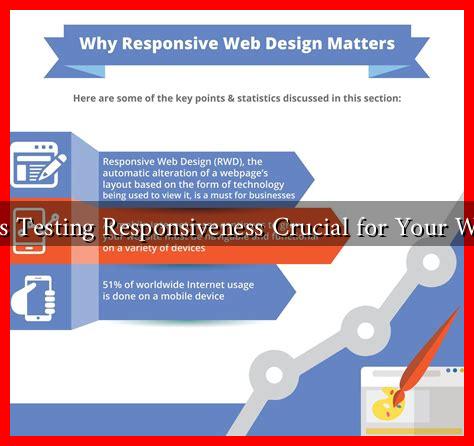-
Table of Contents
Why is Testing Responsiveness Crucial for Your Website
In today’s digital landscape, where users access websites from a myriad of devices, ensuring that your website is responsive is more important than ever. Responsiveness refers to a website’s ability to adapt its layout and content to fit various screen sizes, from desktop monitors to smartphones. This article delves into the significance of testing responsiveness for your website, exploring its impact on user experience, SEO, and overall business success.
The Importance of User Experience
User experience (UX) is a critical factor in determining the success of a website. A responsive design enhances UX by providing a seamless experience across devices. Here are some key reasons why testing responsiveness is vital for UX:
- Accessibility: A responsive website ensures that all users, regardless of their device, can access content easily. For instance, a study by Google found that 61% of users are unlikely to return to a mobile site they had trouble accessing.
- Navigation: Responsive design simplifies navigation, making it easier for users to find what they need. A well-structured mobile site can lead to higher engagement rates.
- Visual Appeal: A responsive website maintains its aesthetic appeal across devices, which is crucial for brand perception. Users are more likely to trust and engage with a visually appealing site.
Impact on SEO
Search engine optimization (SEO) is another critical area influenced by website responsiveness. Google has made it clear that mobile-friendliness is a ranking factor in its search algorithms. Here’s how testing responsiveness can enhance your SEO efforts:
- Improved Rankings: Websites that are mobile-friendly are more likely to rank higher in search results. According to a report by Statista, over 50% of global web traffic comes from mobile devices, making it essential for websites to cater to this audience.
- Reduced Bounce Rates: A responsive design can significantly lower bounce rates. If users find a site difficult to navigate on their device, they are likely to leave immediately. A responsive site keeps users engaged longer.
- Single URL Structure: Responsive websites use a single URL for all devices, which simplifies link sharing and improves the overall user experience. This is favored by search engines, as it consolidates page authority.
Case Studies: Success Stories of Responsive Design
Several companies have reaped the benefits of investing in responsive design. Here are a couple of notable examples:
- Starbucks: The coffee giant revamped its website to be fully responsive, resulting in a 30% increase in mobile orders. The improved user experience led to higher customer satisfaction and loyalty.
- Amazon: By optimizing its website for mobile devices, Amazon saw a significant increase in sales. The company reported that 70% of its traffic comes from mobile devices, underscoring the importance of responsiveness.
Tools for Testing Responsiveness
To ensure your website is responsive, various tools can help you test its performance across different devices:
- Google Mobile-Friendly Test: This free tool allows you to check if your website is mobile-friendly and provides suggestions for improvement.
- BrowserStack: A paid service that enables you to test your website on real devices and browsers, ensuring a comprehensive assessment of responsiveness.
- Responsive Design Checker: This tool allows you to view your website in different screen sizes, helping you identify any layout issues.
Conclusion
In conclusion, testing responsiveness is not just a technical requirement; it is a fundamental aspect of creating a successful online presence. With the increasing reliance on mobile devices for internet access, ensuring that your website is responsive can significantly enhance user experience, improve SEO rankings, and ultimately drive business success. By investing in responsive design and regularly testing its effectiveness, you can create a website that meets the needs of all users, regardless of the device they choose to use.
For more insights on web design and development, consider visiting Smashing Magazine, a valuable resource for web professionals.

